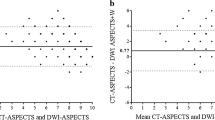Abstract
Magnetic resonance imaging (MRI) has been widely used in intracerebral hemorrhage (ICH) animal models and patients. In the current study, we examined whether MRI can predict at-risk brain tissue during the acute phase and long-term brain tissue loss after ICH. Male Sprague–Dawley rats had an intracaudate injection of autologous whole blood (10, 50 or 100 μL). MRI (T2 and T2*) sequences were performed at days 1, 3, 7, 14, and 28. The volume of brain tissue at risk was calculated as the difference between T2 and T2* lesion volumes. Dopamine- and cAMP-regulated phosphoprotein, Mr 32 kDa (DARPP-32) was used as a neuronal marker in the basal ganglia. Brain swelling at day 3 and brain tissue loss at day 28 after ICH were also measured. We found that the difference in lesion volumes between T2 and T2* measured by MRI coincided well with the difference between the volume of the DARPP-32-negative area and that of the hematoma measured in brain sections. Volumes of brain tissue at risk at day 3 correlated with the brain swelling at day 3 (p < 0.01) as well as the final brain tissue loss at day 28 (n = 9, p < 0.05). The results suggest that the difference between T2 lesions and T2* lesions could be an indicator of at-risk brain tissue and it could be used as a predictor of neuronal loss in ICH patients.
Access this chapter
Tax calculation will be finalised at checkout
Purchases are for personal use only
Similar content being viewed by others
References
Allkemper T, Tombach B, Schwindt W, Kugel H, Schilling M, Debus O, Mollmann F, Heindel W (2004) Acute and subacute intracerebral hemorrhages: comparison of MR imaging at 1.5 and 3.0 T–initial experience. Radiology 232:874–881
Belayev L, Obenaus A, Zhao W, Saul I, Busto R, Wu C, Vigdorchik A, Lin B, Ginsberg MD (2007) Experimental intracerebral hematoma in the rat: characterization by sequential magnetic resonance imaging, behavior, and histopathology. Effect of albumin therapy. Brain Res 1157:146–155
Broderick JP, Adams HP Jr, Barsan W, Feinberg W, Feldmann E, Grotta J, Kase C, Krieger D, Mayberg M, Tilley B, Zabramski JM, Zuccarello M (1999) Guidelines for the management of spontaneous intracerebral hemorrhage: a statement for healthcare professionals from a special writing group of the Stroke Council, American Heart Association. Stroke 30:905–915
Felberg RA, Grotta JC, Shirzadi AL, Strong R, Narayana P, Hill-Felberg SJ, Aronowski J (2002) Cell death in experimental intracerebral hemorrhage: the “black hole” model of hemorrhagic damage. Ann Neurol 51:517–524
Hua Y, Nakamura T, Keep RF, Wu J, Schallert T, Hoff JT, ** G (2006) Long-term effects of experimental intracerebral hemorrhage: the role of iron. J Neurosurg 104:305–312
Hua Y, Schallert T, Keep RF, Wu J, Hoff JT, ** G (2002) Behavioral tests after intracerebral hemorrhage in the rat. Stroke 33:2478–2484
Jadhav V, Sugawara T, Zhang J, Jacobson P, Obenaus A (2008) Magnetic resonance imaging detects and predicts early brain injury after subarachnoid hemorrhage in a canine experimental model. J Neurotrauma 25:1099–1106
Kharatishvili I, Sierra A, Immonen RJ, Grohn OH, Pitkanen A (2009) Quantitative T2 map** as a potential marker for the initial assessment of the severity of damage after traumatic brain injury in rat. Exp Neurol 217:154–164
Svenningsson P, Nishi A, Fisone G, Girault JA, Nairn AC, Greengard P (2004) DARPP-32: an integrator of neurotransmission. Annu Rev Pharmacol Toxicol 44:269–296
Wu G, ** G, Hua Y, Sagher O (2010) T2* magnetic resonance imaging sequences reflect brain tissue iron deposition following intracerebral hemorrhage. Transl Stroke Res 1:31–34
Wu J, Hua Y, Keep RF, Nakamura T, Hoff JT, ** G (2003) Iron and iron-handling proteins in the brain after intracerebral hemorrhage. Stroke 34:2964–2969
** G, Hua Y, Bhasin RR, Ennis SR, Keep RF, Hoff JT (2001) Mechanisms of edema formation after intracerebral hemorrhage: effects of extravasated red blood cells on blood flow and blood-brain barrier integrity. Stroke 32:2932–2938
** G, Keep RF, Hoff JT (2006) Mechanisms of brain injury after intracerebral haemorrhage. Lancet Neurol 5:53–63
** G, Keep RF, Hua Y, **ang J, Hoff JT (1999) Attenuation of thrombin-induced brain edema by cerebral thrombin preconditioning. Stroke 30:1247–1255
Yoshioka H, Niizuma K, Katsu M, Okami N, Sakata H, Kim GS, Narasimhan P, Chan PH (2011) NADPH oxidase mediates striatal neuronal injury after transient global cerebral ischemia. J Cereb Blood Flow Metab 31:868–880
Acknowledgements
This study was supported by grants NS-017760, NS-039866, and NS-057539 from the National Institutes of Health (NIH) and 0840016N from the American Heart Association (AHA). The content is solely the responsibility of the authors and does not necessarily represent the official views of the NIH and AHA.
Conflict of InterestWe declare that we have no conflict of interest.
Author information
Authors and Affiliations
Corresponding author
Editor information
Editors and Affiliations
Rights and permissions
Copyright information
© 2013 Springer-Verlag Wien
About this paper
Cite this paper
**, H. et al. (2013). T2 and T2* Magnetic Resonance Imaging Sequences Predict Brain Injury After Intracerebral Hemorrhage in Rats. In: Katayama, Y., Maeda, T., Kuroiwa, T. (eds) Brain Edema XV. Acta Neurochirurgica Supplement, vol 118. Springer, Vienna. https://doi.org/10.1007/978-3-7091-1434-6_28
Download citation
DOI: https://doi.org/10.1007/978-3-7091-1434-6_28
Published:
Publisher Name: Springer, Vienna
Print ISBN: 978-3-7091-1433-9
Online ISBN: 978-3-7091-1434-6
eBook Packages: MedicineMedicine (R0)




